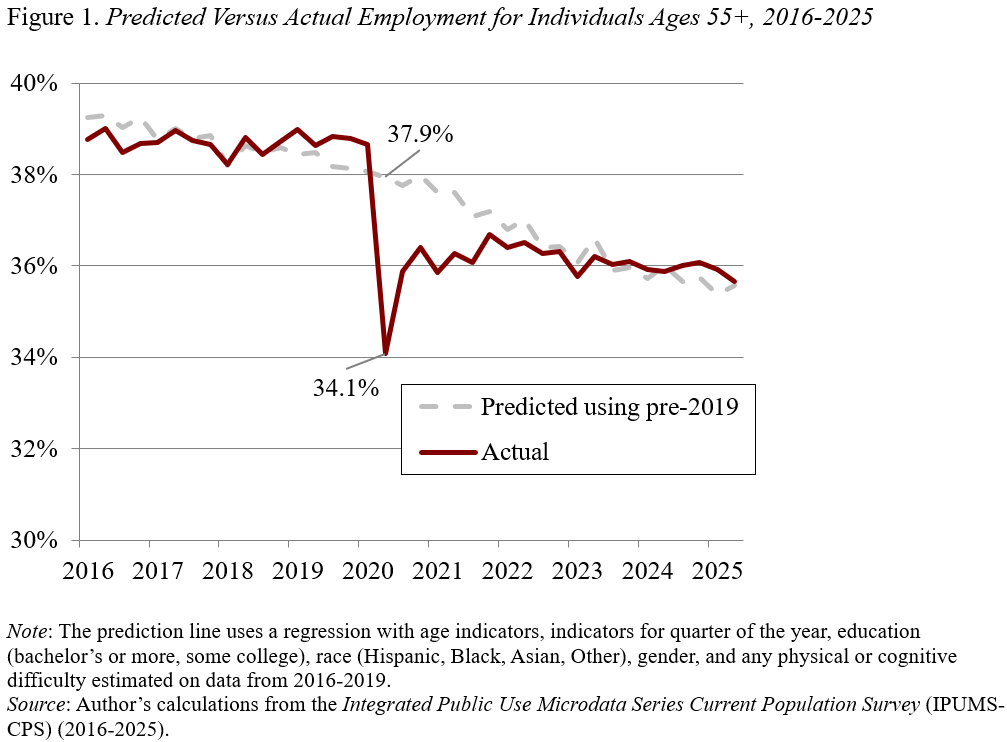
One Surprising Thing That COVID-19 Didn’t Change
Geoffrey T. Sanzenbacher is a columnist for MarketWatch and a professor of the practice of economics at Boston College. He is also a research fellow at the Center for Retirement Research at Boston College.
In a Post-COVID world, are older people working?
Sometimes, on a lazy summer afternoon, I like to go into the Current Population Survey – the monthly survey that yields the government’s estimate of the unemployment rate – and just tabulate away. What can I say, my social life just isn’t what it used to be. Recently, I noticed something disturbing. On the eve of the COVID-19 pandemic, in the fourth quarter of 2019, 38.8 percent of workers ages 55+ were employed. Today, that number is 8 percent lower, at 35.7 percent. As someone who has spilled a fair amount of ink extolling the financial values of working longer when possible, I was concerned by this downturn.
So, I decided to investigate further, and got the go-ahead to write an upcoming issue brief for my friends at the Center for Retirement Research at Boston College. The brief explores two possibilities for the decline in employment among older workers. The first possibility is that, for some reason, older workers are in fact less likely to work in the post-COVID world. Perhaps they fear the health impact of in-person employment. Or, maybe the increase in asset prices that has occurred in the last four years has allowed people to stay retired who otherwise would have come back to work. It’s even possible that some workers who gave up looking for work during the peak of the pandemic have yet to come back, a phenomenon that lasted nearly a decade after the Great Recession.
The second possibility is simpler. Maybe the demographics of the population have changed in the post-pandemic world in a way that makes work less likely among those ages 55+. In other words, maybe apples-to-apples, people are just as likely to work today as they were before the pandemic. After all, the average age of those ages 55+ was 67.6 in the fourth quarter of 2019. Today, it’s a year higher at 68.6. Since people work less as they age, this extra year could explain the decline in employment I was observing. It’s possible people today are just as likely to work at any given age as before the pandemic, they’re just older now.
To see which of these possibilities it is, I did a little prediction exercise. First, I ran a regression using only data from before COVID that attempted to predict people’s employment using their age, their education, their race/ethnicity, their gender, and whether they reported health difficulties. Next, this regression is used to predict the likelihood that people in the post-COVID period would have worked if they acted just like people who were otherwise similar from prior to the pandemic. Finally, this prediction is compared to what actually happened. This exercise asks: are otherwise similar people now working more or less than expected based on the years preceding the pandemic? Figure 1 plots the results with the prediction line in gray dashes and the actual line in red.

The figure shows that, prior to COVID-19, the probability of working for those ages 55+ was nearly flat. During the COVID period, employment was predicted to drop slowly as the population aged. Instead, in Q2 2020, employment dropped 10 percent more than expected, down to 34.1 percent versus a prediction of 37.9 percent. However, the figure also shows a gradual return to the prediction. Indeed, today, the pre-COVID prediction and the actual line are almost identical. Comparing apples-to-apples, individuals ages 55+ are almost exactly as likely to work in 2025 as they were on the eve of the pandemic.
Indeed, to me, this return to normal is one of the successes of policy in the wake of the pandemic. Recessions can have long tails. But the stimulus provided by the first Trump Administration and then the Biden Administration got things back to normal in the labor market much faster than had happened during the Great Recession. Although we can debate whether those policies also had a cost – excessive inflation – the benefit seems to be that older workers have been able to return to work much as before the pandemic. Given the size of the shock to the economy that COVID-19 represented, this feat shouldn’t be taken for granted.







